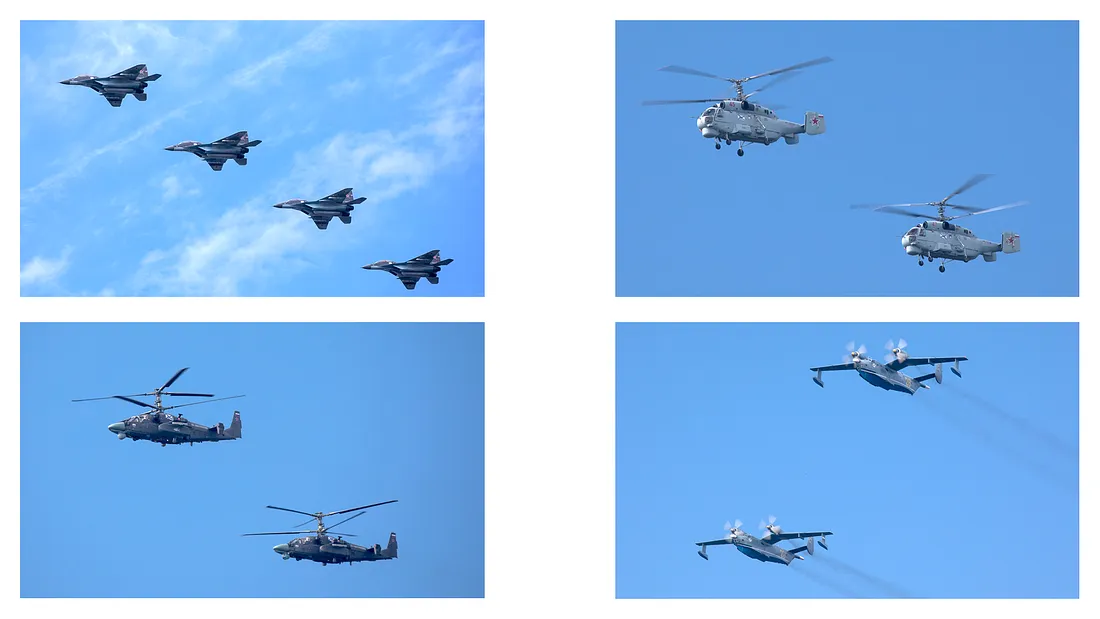A Guide to Russia’s Navy Day
The Russian Federation’s naval parades in Syria, Crimea, St. Petersburg, and Vladivostok
A Guide to Russia’s Navy Day
Share this story

BANNER: Source: Russian Ministry of Defense
On July 30, the Russian Federation celebrated Navy Day with some 100 vessels across its ports in St. Petersburg; Vladivostok; Novorossiysk; Baltiysk, Kaliningrad; Tartus, Syria; and illegally-occupied Sevastopol, Crimea, Ukraine. Admiral Aleksandr Vitko, commander of the Black Sea Fleet, announced plans to continue developing the Russian naval forces with a frigate, two large diesel submarines, small missile ships, patrol ships, and communications ships. The navy also recently introduced two new frigates, four diesel submarines, anti-sabotage ships, and several smaller vessels. Official photos from the events display an array of air and naval equipment.
St. Petersburg
St. Petersburg hosted the main naval parade off of Kronshtadt, an island near the city, with around 40 vessels including the Admiral Grigorovich-class frigate Admiral Makarov (pennant no. 799), the Kirov-class heavy missile battlecruiser Pyotr Velikiy (“Peter the Great,” pennant no. 099), the Slava-class cruiser Marshal Ustinov (pennant no. 055), the Udaloy-class destroyer Vice Admiral Kulakov (pennant no. 626), and the Kuznetsov-class heavy aircraft carrier Admiral Flota Sovetskogo Soyuza Kuznetsov (“Admiral of the Fleet of the Soviet Union Kuznetsov,” pennant no. 063).



Three Chinese warships — the Type-052D destroyer Hefei (NATO reporting name “Luyang III-class” or “Kunming class” and pennant no. 174), the Type-054A frigate Yuncheng (NATO reporting name “Jiangkai II” and pennant no. 571), and the supply ship Luoma Lake (pennant no. 964) — participated in the main naval parade in St. Petersburg. As @DFRLab previously reported, the three Chinese warships were just in Russia’s western port in Baltiysk, Kaliningrad, participating in the “Maritime Cooperation-2017” bilateral naval exercises in the Baltic Sea.


Crimea
Celebrations in illegally-occupied Crimea included a display of more than 30 ships and 20 aircraft and helicopters from the Southern Military District’s (SMD) Air Force and Air Defense forces.

Notably, the Admiral Grigorovich-class frigate Admiral Grigorovich (pennant no. 494), the Slava-class cruiser Moskva (pennant no. 121), and the new Kilo-class B-262 Staryy Oskol attack submarine participated in the parade. The Admiral Grigorovich is noteworthy for having previously traveled to the eastern Mediterranean in April 2017 following two U.S. Navy destroyers’ launching 59 Tomahawk cruise missiles at the Al Shayrat airfield in Syria. The Staryy Oskol is noteworthy for having been previously intercepted by British Royal Navy ships near the English Channel in June 2016; it is capable of carrying cruise missiles and torpedoes.
Пара вертолетов Ка-52 пролетает над кильватерным строем кораблей в Севастополе во время празднования Дня Военно-Морского Флота России pic.twitter.com/1RqZIEmFjB
— Минобороны России (@mod_russia) August 1, 2017
Air forces on display included deck-mounted KA-52K “Katran” (NATO reporting name “Hokum-B”) helicopters, Kamov KA-27 and KA-29 (NATO reporting name “Helix”) helicopters, Ilyushin Il-38 “Dolphin” (NATO reporting name “May”) anti-submarine warfare (ASW) aircraft, Tupolev Tu-142 and Tu-142M (NATO reporting name “Bear F/J”) maritime reconnaissance and ASW aircraft, Sukhoi Su-33 (NATO reporting name “Flanker-D”) fighters, and Mikoyan MiG-29K (NATO reporting name “Fulcrum-D”) fighters.
Tartus, Syria
For the first time, Russia’s Navy Day was celebrated at the port in Tartus, Syria. Equipment included the Improved Kilo Varshavianka-class B-265 Krasnodar submarine from the Baltic Sea Fleet. Russia’s Navy Day celebrations in Tartus displayed Russia’s newly expanded military presence in Syria as delineated in a bilateral, long-term agreement in January.
Conclusion
As with most Russian military celebrations, Navy Day was primarily a platform to display Russia’s military prowess. Notable developments compared to prior celebrations include holding festivities in Syria, the participation of Chinese warships in the main parade, and new frigates and submarines.
Several of the Russian Baltic Sea Fleet vessels that participated in the parade in St. Petersburg will return to their permanent base in Baltiysk, Kaliningrad. En route to Baltiysk, they will participate in joint training exercises with vessels from Russia’s Northern Fleet.

